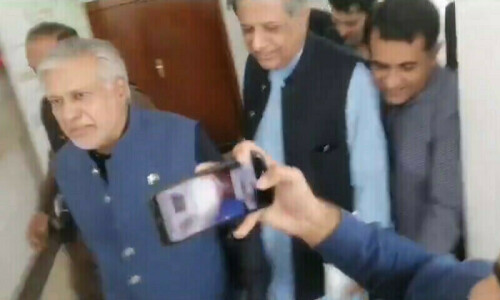TOKYO: Masayo Isurugi settles into a booth on the sixth floor of a sleek Tokyo building, scans an ID card and waits for an automated system to deliver her late husband’s ashes.
More and more people in Japan are breaking with traditions on burial and mourning, swapping hometown graveyards for modern takes on cemeteries.
As the 60-year-old waits in one of ten mourning booths on the floor, cranes behind the walls move almost silently and retrieve the “zushi” box with the urn containing her late husband Go’s ashes.
Chic wooden doors inside the booth quietly part like an elevator at a luxurious hotel and a gleaming, dark-stone altar emerges with Go’s zushi box as its centrepiece, while a photo of him appears on a monitor.
“Initially, I thought maybe these facilities might feel cold and that I might prefer a traditional grave on soil,” Isurugi said.
“Now I feel it’s better to have a place where I can visit whenever I want and offer prayers, rather than having a family grave that I could rarely visit.” Her family considered a traditional cemetery, but it was a two-hour train ride away. The Kuramae-ryoen facility is only brief bus ride from Isurugi’s house and she can visit after work.
Traditionally in Japan, cremated remains are placed in family tombs used over many generations and tended by the family’s eldest sons.
But Japan’s disproportionately greying population makes for an imbalance between the number of new graves needing tending and the young people willing and able to do it.
Families are increasingly moving to urban areas far from ancestral graveyards, and many elderly don’t have sons who can take on the traditional responsibility.
Tomohiro Hirose, resident monk at the temple that supervises the Kuramae-ryoen facility, has a traditional cemetery with some 300 graves.
“But about half of the graves no longer have anyone in the family to look after them,” he said.
To address the problem, a crop of modern, indoor cemetery facilities have emerged, offering to store remains for a set period, often up to three decades.
The ashes are eventually transferred to collective memorials, but individual names or QR codes are engraved on plaques to provide some personalisation, and monks pledge to continue offering prayers for the souls of the departed.
Facing a busy boulevard in the Japanese capital, Kuramae-ryoen features warehouse-style industrial stacking racks that can store 7,000 zushi boxes, each of which can hold two urns or the bagged ashes of up to eight people.
Published in Dawn, April 22nd, 2022












































